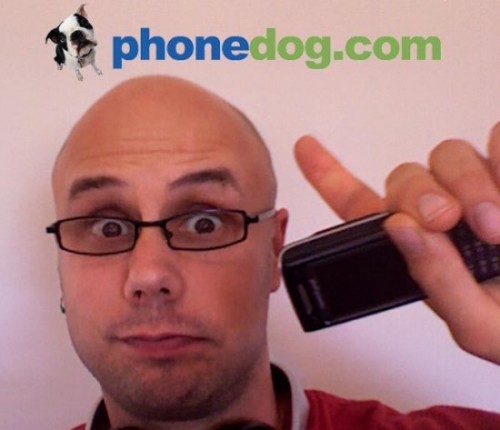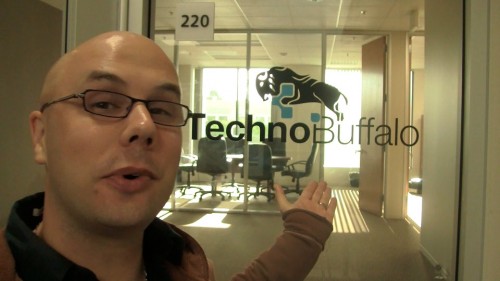What is an identity worth? According to PhoneDog, a ‘personality-driven’ tech-review site, Noah Kravitz’s identity is valued at $42,500 per month. A former employee of PhoneDog, Kravitz successfully acquired a large following on the microblogging site Twitter—17,000 at the time of his leaving. In an attention economy, each follower becomes a valuable and tangible asset. The legal dispute between Kravitz and PhoneDog is over ownership of these 17,000 assets.
When Kravitz left the company, he changed his Twitter handle from @PhoneDog_noah to @noahkravitz and took his growing list of followers with him (I became his 24,390th follower/asset today). Complicating the issue further, he now writes for TechnoBuffalo, a competing tech news site which presumably benefits from Kravitz’s vast following. Last week, a federal judge granted permission for the case to move forward. The existence of such a case, as well as its outcome (which remains yet unseen) both demonstrates and further constructs the shifting relationship between identity, labor, private rights, and worker obligations.
PhoneDog argues that Kravitz’s extensive network was built on the company’s foundation—and on the company’s dime. The notoriety of the site and the legitimacy of the name (i.e. the attachment of PhoneDog to his Twitter handle) facilitated the growth of Noah’s online persona. Moreover, they invested in a sizeable PR campaign to grow PhoneDog’s social media presence, and promoted Noah as the representative. Not only did this help raise Noah to micro-celebrity status, but made him an influencer—or someone who has enough influence to sell ad space. In short, PhoneDog argues that Kravitz gained his followers under the PhoneDog name and under the PhoneDog payroll, making these followers the property of the company. They estimate that each of his followers is worth $2.50 per month, and they seek reparations. In a message to readers dated January 3rd 2012, PhoneDog describes Noah’s rise to fame as follows:
Noah joined the PhoneDog team in April 2006. During that period, PhoneDog.com was in the very early stages of becoming the personality-driven mobile tech review site it is today. We found Noah to be a very talented and charismatic editor/video blogger and an excellent addition to represent PhoneDog. Over the next four years, we invested in Noah and the site by sending him to trade shows and conferences from San Francisco, Vegas, New York, Barcelona and many places in between. We hired PR agencies to increase PhoneDog’s exposure and Noah was frequently featured on CNBC, FOX Business, and other national and local media outlets. During this time, we also expanded our efforts into many forms of social media, starting with our YouTube channel, then to Twitter and facebook respectively; each with the very specific intent to grow PhoneDog’s social media following and its loyal audience. From all of our efforts, the site’s popularity continued to grow and Noah essentially became a micro-celebrity of sorts. What started out as a small part-time freelance opportunity grew into a very well paid career for Noah.
Kravitz, of course, tells a different story. In a recent interview with CNN, Kravitz claims that his contract allows him to keep his Twitter account and all of its followers. His talents made him an influencer, and brought both notoriety and monetary gain for the PhoneDog company. He argues that it is contractually permissible for him to bring his talents and assets (i.e. followers) with him into new business ventures. Moreover, he argues that it is ridiculous to put a monetary value on individual Twitter followers, and that if one did attempt to do so, PhoneDog’s calculations would likely be inaccurate. To this latter point, he says in a post on TechnoBuffalo:
The suit attempts, amongst other things, to place a monetary value on the worth of an individual follower of a social media account. Human being or spambot, you’re all worth two bucks and fifty cents. Per month. Just for fun, multiply $2.50 by @ladygaga and her 17,355,730 Little Monsters. I’ll do it for you: $43,389,325.00 USD. That’s 43 million dollars per month, rounded down. I wonder how many countries on Earth, let alone private corporations, generate that kind of monthly revenue?
What does it all mean?
This case is heralded by many as a ‘landmark’ case in social media. With increasingly blurry lines separating personal and professional, private and public, rules about content and identity ownership are yet underdeveloped, and cases such as this help construct legal boundaries.
More generally, a case such as this speaks to a seemingly polemic tension between increasing creativity and agency of the contemporary worker, and increasing surveillance and alienation. The precedent set by this case will go a long way in tipping the scales towards one end or the other.
As social media becomes an embedded and necessary component of commercial enterprises, employees are asked to engage with customers—established and potential—through these platforms, and in the style of these platforms. This style is largely informal and personality-driven. Employees who represent a company via social media are only as valuable as they are charismatic. But to who does this charisma—and the assets which it acquires– belong?
PhoneDog argues that they belong to the company under which the charismatic worker is/was employed. Kravitz argues that they belong to the worker, who is free to keep and/or sell both charisma and charismatically gained assets.
If the courts side with PhoneDog, then the scales tilt towards increased surveillance and alienation of the contemporary worker. With this model, the worker has only hir personality to sell. S/he literally gives part of hir self to the enterprise, who shapes, regulates, exploits, and bounds that self for commercial and financial ends. The worker is decoupled from the capital that s/he creates, while hir very identity becomes entwined with those on whom s/he financially depends. In describing this dismal potential, Communication scholar Mark Andrejevic says:
…if digital technology makes it possible to work outside the office, recent innovations enable the workplace to exploit the productivity of our social lives outside the workplace…By capturing and channeling user-generated activity for marketing purposes, emerging forms of online commerce subsume the potential diversity of social life to narrower commercial interests (pg. 83).
If the courts side with Kravitz, however, it predicts greater agency for the contemporary worker. The worker’s charismatic labor, though bound by the confines of the enterprise for whom s/he currently represents, can also increase personal, transferable capital—capital that makes the worker, not just the enterprise, a valuable commodity. The worker can more creatively construct hir online persona, and if successful, can benefit from the fruits of hir labor. With this model, the worker has followers—and so chips—with which to bargain. As s/he builds a brand for the company, s/he simultaneously builds a brand of hirself. With this model, the blurring of personal and professional liberates and empowers the worker.
It is this latter scenario that, in my (admittedly biased) opinion, should prevail. Kravitz was hired due to his ability to maintain a fan base. As an employee of PhoneDog, he did this job well. To sue him for taking his skills—and the assets obtained with these skills—to another venue would be the same as suing a print journalist for taking readers with hir to a new newspaper. Moreover, if he was not able to bring his network with him, nor tweet under his own name, Kravitz would literally have nothing to sell on the market, binding him in a relation of vastly unequal dependence to his employer. Finally, no company has the ability to control customer choice. Readers in this case developed loyalty to a particular journalist. It is up to PhoneDog to create strong enough content to lure them back and/or keep them reading.
Follow me on Twitter: @Jup83




Comments 2
What is an identity worth? « SocioKlub. — February 14, 2012
[...] na povezavi: (klik) Like this:LikeBe the first to like this post. Comments RSS [...]
Emily — February 16, 2012
Very interesting. I think what should be made even more explicit here is that social media tips the scale on the benefit that employees can take away from work. Not just experience and skill, but (pseudo)tangible assets.
I wonder what companies and individuals will do differently in future? by more strictly policing this, "encouraging" their stars to tweet primarily under their corporate handle? Or maybe workers will be more savvy about insisting that they keep their twitter names non-corporate.